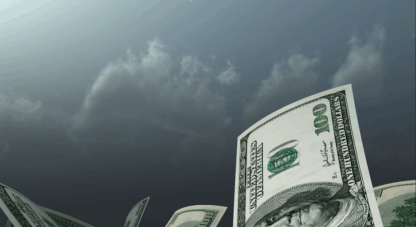As Lincoln’s War was getting underway, people streamed out of Washington DC to watch the first battle of Bull Run, bringing picnic lunches with them so they could enjoy the immediate and highly entertaining defeat of Confederate forces.
Later, people partied and celebrated as they launched and then sailed the “unsinkable” ship Titanic. And the Roaring ’20s roared because there was so much money sloshing around that the decade was a continuous party—until Black Thursday, at any rate.
This is not to say that parties cause catastrophes. It’s just to say that popular sentiment is a poor predictor of future events. Charles Mackay got it right when he wrote Extraordinary Popular Delusions and the Madness of Crowds. People are herd animals, and herds are not reliable prognosticators.
Since Jerome Powell’s dovish comments late last year, markets have been on a tear. They were previously certain that a policy pivot would occur, so the Chair’s comments seemed to be merely an acknowledgement of the inevitable. But with his most recent comments, he seems to be speaking out of the other side of his mouth. A March rate cut is apparently not in the offing. What to do?
Well, the market has an opinion on that, and the market is a herd. Will it be right this time, or is it again taking the northbound ship to Antarctica? Much is riding on the outcome, and much is riding on the right answer. In fact, much is much too small a word. Unfathomable sums of money and assets are in play.
If your assets and funds are part of the much, you’d do well to read the publications summarized below. Both opportunity and danger loom, and knowing one from the other is key. Don’t go it alone. These analysts are keenly insightful, and while they’re quick to collaborate with colleagues or read the work of experts, they are severely allergic to herds.
Key Takeaways:
- Borrowing our way to prosperity
- The Fed ignores “the rest of the story”
- The market bets on Fed error
- The role of gold in an uncertain world
The McAlvany Weekly Commentary: Given the trouble in the Middle East, the price of gas in America is a surprise. David and Kevin discuss the reasons for the counterintuitive pricing, and in the process give a fascinating overview of the oil supply situation worldwide. One aspect of that overview is that when it comes to supply and demand, it’s all about balance. And when geopolitical factors are volatile, balance is a hard-bought thing. The hosts also discuss the burnished and beaming GDP numbers calculated recently, and note that those numbers are likewise deceptive. You can put a sick man in an ice bath and get his temperature down, but that doesn’t mean you have healed him. Similarly, you can pour so much money into the economy that the GDP is artificially juiced up, but that doesn’t mean it’s healthy. America has been spending $1.55 in debt to produce $1.00 in GDP, which is a mark of sickness, not health—hopes and celebrations to the contrary notwithstanding. The hosts also discuss the courage and character of Texas governor Greg Abbott, and the stubborn strength of gold.
Credit Bubble Bulletin: Doug begins his analysis this week with comments made by Jerome Powell in a CNBC interview with Jeff Cox. Powell believes the economy is strong, but is unconcerned that that fact will re-stoke inflation. He cites strong employment figures as evidence of strength, while saying that growth will moderate as supply chain and labor market “normalization” occurs. He also maintains that financial conditions are restrictive, even in the face of massive evidence to the contrary. Clearly, he equates Fed interest rate increases with tight policy, as though there were no other actors involved in the equation. Doug discusses these other actors and the consequences of their involvement. In light of their actions, “the so-called ‘neutral rate’ [the policy rate level required to restrain overall credit growth] at this stage of the cycle is so much higher than today’s analysts and Fed officials have ever contemplated.” Late-cycle dynamics predominate in speculation, leverage, and deficit spending.
Hard Asset Insights: Writing while suffering from the flu this week, Morgan’s comments were as insightful and hard-hitting as ever—albeit shortened. Like Doug, he discussed Jerome Powell’s comments and their sanguine tone regarding any imminent increase in inflation. Powell did, however, push back against expectations for a March interest rate cut. And there’s the rub. “When Powell said March rate cuts were unlikely, the market predictably slashed the odds of a March rate cut. Of much greater interest, however, was the fact that, rather than eliminate expectations for those cuts or expect them to be delayed, the futures market instead immediately priced in a greater total number of rate cuts later in 2024… The message was clear: we are dealing with the increased likelihood of a Fed policy error in which delaying cuts will necessitate more and/or larger rate cuts later as an emergency response measure.” That’s big! Click the link for the rest of Morgan’s analysis.
Golden Rule Radio: Rob and Miles host the program again this week, quickly looking at the charts to view the consequences of Jerome Powell’s comments and decision not to cut interest rates. Stocks immediately headed down, and bonds seem to be benefitting as a result (with exceptions). After looking at several of the stock charts, Miles concludes, “I would expect a bit of a blow-off here through February.” This prompts the hosts to look at gold, which has been heading mildly lower but often gains when equities lose. Miles states that he expects a pullback further in the short term, but is long-term bullish. Rob agrees that the technical considerations are mildly bearish, but the hosts then turn to global conditions for greater context. This widens the scope of the discussion greatly, and the hosts discuss possibilities in light of where global conditions might take us.















